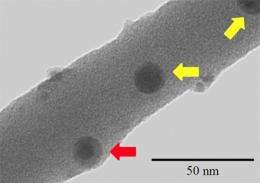Development of world’s first functional polymer nanowire fabrication technology by pulsed laser irradiation

Japanese researchers selectively grew polymer nanowires using only irradiation with a pulsed laser, in a region limited to the area of irradiation. They also succeeded in imparting diverse functionalities to the nanowires by doping with various species of nanomaterials.
Polymer nanowires have important advantages for industrial applications in comparison with nanowires made from inorganic materials. Because they are extremely flexible and are also optically transparent, wide application is expected in new nanodevice fields such as sensors, light-emitting devices, optical switch devices, and others. However, it had not been possible to solve two problems which were obstacles to practical application of nanodevices using polymer nanowires. One was the need to substantially reduce the size of the nanowire, and the other was addition of various dopants to impart new functions. In the present work, the NIMS researchers proposed an extremely simple method using only a pulsed laser, which is completely different from the conventional fabrication method, and simultaneously solved the above-mentioned two problems.
Nanodevices have attracted attention because new functions that were not possible with conventional devices can be obtained by utilizing the quantum size effect, which is first manifested when the size of a device is reduced to its ultimate limit. In order to obtain the quantum size effect, it is necessary to refine the diameter of nanowires down to several 10nm or less. Molds are used in the conventional nanowire fabrication technique, but fabrication by this method had been limited to comparatively thick wires with diameters of several 100nm. Furthermore, with the conventional technique, polymer nanowires were extracted from the mold by etching (dissolving) the mold with a strong chemical agent, and it was only possible to use polymers that would not be damaged by the chemical.
In this pioneering research, the NIMS team developed a completely new technique, which is the world’s first of its kind, by simply irradiating a highly-controlled laser on the material without using a mold, thereby causing a nanowire to form at the position of irradiation as though growing. It was also possible to impart diverse functions to the formed nanowires, which had been difficult until now, by adding various dopants to the starting material.
Because this newly-developed functional polymer nanowire fabrication technique can be applied to arbitrary functional nanomaterials and diverse polymers as necessary, practical application of the functional polymer materials obtained by this method is expected in the future in fields such as wiring for flexible substrates of smart phones, where increasingly active development is anticipated, and in flexible high magnetic permeability materials in antennas for portable electronic devices, where miniaturization is required.
Provided by National Institute for Materials Science
















